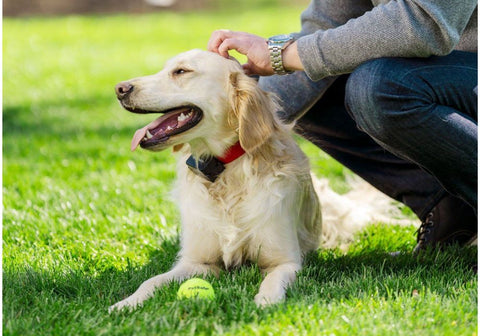The Comprehensive Guide to E-Collar Training for Dogs

Imagine a world where training your dog feels less like a struggle and more like a fun conversation. E-collar training can serve as that bridge, offering a clear and effective means of communication with your furry friend.
This guide aims to provide you with a comprehensive understanding of e-collar training. We'll debunk common myths and empower you with the knowledge necessary to train your dog successfully and responsibly. Keep reading to delve deeper into this topic.
Understanding E-Collars: What They Are and How They Work
E-collars, also known as remote training collars or electronic collars, are tools used in dog training. They consist of a collar that goes around the dog's neck and a handheld remote control. The remote allows the trainer to deliver a mild stimulation to the dog through the collar. This stimulation is designed to get the dog's attention and reinforce positive behavior during training sessions.
Dog e-collars work by delivering a brief, harmless electric pulse through the contact points on the collar. The intensity of the stimulation can be adjusted to fit the individual dog's temperament and training needs. Modern e-collars are not intended to cause pain or discomfort to the dog but serve as a gentle reminder during training.
Modern E-Collars vs. Shock Collars
It's crucial to distinguish modern e-collars from the outdated and inhumane shock collars of the past. Traditional shock collars delivered a constant, high-level electrical shock, often causing pain and distress to the dog. In contrast, today's e-collars are designed with safety features and adjustable stimulation levels, allowing for a more humane training experience.
Modern dog e collars have undergone significant improvements in technology and design. They often incorporate different stimulation modes, such as vibration or tone, in addition to electrical stimulation. This versatility allows trainers to tailor the training approach to each dog's unique needs and temperament.

5 Benefits of E-Collar Dog Training
E-collar training, when done correctly and responsibly, can offer numerous advantages for both dog owners and their canine companions. Here are some of the key advantages of e collar dog training:
1. Effective Communication from a Distance
E-collars allow you to communicate with your dog effectively, even from a significant distance. This proves helpful when verbal cues or hand signals fail, such as during recall exercises or in highly distracting environments. The ability to reinforce desired behaviors or interrupt unwanted ones from a distance can greatly enhance the training process.
2. Addressing Stubborn or Difficult Behaviors
Some dogs may be particularly stubborn, strong-willed, or have high prey drives, making traditional training methods less effective. E-collars can provide an additional layer of communication, helping you break through these barriers and address even the most challenging behaviors. With the right techniques, e-collars can be invaluable in curbing excessive barking and managing reactivity towards other dogs or people.
3. Increased Safety and Control
By establishing a clear line of communication with your dog, e-collars can enhance safety and control in various situations. For example, during off-leash activities, the ability to recall your dog quickly and effectively can prevent accidents or dangerous encounters. Additionally, e-collars can be especially useful for hunting dogs, where reliable obedience and responsiveness are crucial.
4. Versatility in Training
E-collars offer versatility in training, allowing you to adapt to different scenarios and goals. Many modern e-collars come equipped with various stimulation modes, such as vibration, tone, or static stimulation. This versatility enables you to tailor the training approach to your dog's needs and temperament, ensuring a more personalized experience.
5. Combining with Positive Reinforcement
E collars for dogs should always be used in conjunction with positive reinforcement techniques, such as treats, praise, and play. This balanced approach not only strengthens the bond between you and your dog but also creates a more enjoyable training experience. Positive reinforcement helps to reinforce desired behaviors, while the e-collar acts as a gentle reminder or interrupter when needed.
Getting Started with E-Collar Training
Getting started with e collar training can seem daunting. However, with the right approach and guidance, it can be a smooth and rewarding process. Here are the key steps to get started with e-collar training:
Initiating E-Collar Training for Your Dog
Before diving into e-collar training, it's crucial to establish a strong foundation of basic obedience training using positive reinforcement methods. This includes teaching dog obedience commands like "sit," "stay," "come," and "heel." Here's why this pre-training is crucial:
- Building Trust and Confidence: Positive reinforcement creates a positive association with training. Your dog learns that following your commands leads to treats, praise, and fun. This trust and confidence are vital for introducing a new training tool like an e-collar.
- Clear Communication: With basic commands mastered, your dog understands what you expect. The e-collar then becomes a gentle reminder to reinforce these existing behaviors.
- Success from the Start: By introducing the e-collar after some initial training, your dog is already familiar with the desired actions. This sets you both up for success in the e-collar training phase.

Proper E-Collar Fitting and Usage Guidelines
Proper fitting of the e-collar is essential for both effectiveness and safety. The e-collar should sit snugly but comfortably on your dog's neck. A good rule of thumb is the two-finger test. Slide two fingers comfortably between the collar and your dog's neck. This ensures proper contact without irritation.

Moreover, regularly inspect your dog's neck for signs of irritation, redness, or discomfort. Look for any rubbing or matting of fur, and adjust the fit accordingly. If you notice any discomfort, take a break from the training and consult your veterinarian.
Step-by-Step Guide to E-Collar Training
E-collar training is a gradual process that requires patience, consistency, and a structured approach. It's essential to follow a step-by-step plan to ensure your dog's comfort, understanding, and success. Here's a detailed guide to help you navigate the process:
Step 1: Getting Your Dog Comfortable with the E-Collar
- Start by allowing your dog to become familiar with the e-collar itself. Let them wear it around the house without any stimulation, treating and praising when they remain calm and relaxed.
- Gradually increase the time your dog wears the collar, ensuring it's fitted properly and not causing any discomfort.
- Once your dog is comfortable wearing the collar, you can begin introducing the stimulation levels in a controlled, distraction-free environment.
Step 2: Conditioning to the Stimulation
- Start with the lowest stimulation level and pair it with a positive marker, such as a clicker or a verbal cue like "yes."
- Immediately follow the stimulation with a high-value treat and praise to create a positive association.
- Repeat this process, gradually increasing the stimulation level until you find the lowest level that reliably gets your dog's attention.
- Remember to keep sessions short and end on a positive note.
Step 3: Reinforcing Known Commands
- Once your dog is comfortable with the stimulation levels, begin incorporating the e-collar into training sessions. Do this by reinforcing commands they already know, such as sit, stay, or come.
- Use the e-collar stimulation as a reinforcement tool, delivering a brief stimulation followed by a command. Reward with a treat and praise when your dog responds correctly.
- Gradually increase the distraction level and distance, ensuring your dog maintains a solid understanding of the commands with the e-collar.
Step 4: Introducing New Commands and Behaviors
- After successfully reinforcing known commands with the e-collar, you can start introducing new commands and behaviors.
- Break down new behaviors into smaller, manageable steps, using the e-collar. Think of them like building blocks. For example, teaching "stay" might involve separate steps for duration (holding the stay for a few seconds) and distance (gradually increasing the space between you and your dog).
- Use the e-collar strategically as a "marker" during each successful step. A brief, low-level stimulation can pinpoint the exact moment your dog performs the desired action. Immediately follow this with a reward (treat, praise, or play) to solidify the positive association.
- Be patient and consistent, gradually building upon each step until the desired behavior is achieved.
Step 5: Maintenance and Proofing
- Once your dog has mastered the commands with the e-collar, it's important to reinforce these skills through regular practice sessions. Short, focused training sessions throughout the week are more effective than long, sporadic ones.
- "Proofing" refers to testing your dog's obedience in various environments. Once your dog performs consistently with distractions during training sessions, take your practice on the road. Try the commands in different locations like the dog park, a friend's house, or a bustling sidewalk. The goal is for your dog to respond reliably regardless of the situation.
- As your dog progresses, you can gradually decrease the reliance on the e-collar. Use it primarily as a gentle reminder for correct behavior, pairing it consistently with positive reinforcement like treats, praise, or playtime. The ultimate goal is for your dog to obey commands based on your verbal cues alone.
If you encounter any challenges or have specific questions, seek guidance from a professional dog trainer experienced in e-collar training. Their expertise can help you navigate any hurdles and ensure you're on the right track to success.
The Dos and Don'ts for E-Collar Training Success
To ensure a smooth and positive e-collar training experience for you and your dog, here are some key Dos and Don'ts to follow:
Dos
- Positive Reinforcement is King: Always pair e-collar stimulation with positive reinforcement techniques like treats, praise, and playtime. This creates a happy association with training and motivates your dog to learn.
- Start Low, Go Slow: Begin with the e-collar on the lowest setting and gradually increase intensity only if necessary. Remember, a gentle reminder is all you need.
- Clear Communication is Key: Use clear and consistent verbal cues (like "sit" or "heel") every time you deliver stimulation. This creates a strong association between the word, the stimulation, and the desired behavior.
- Short and Sweet Training Sessions: Keep training sessions short, focused, and positive. Think quality over quantity. A tired or frustrated dog is less receptive to learning.
- Patience is a Virtue: Learning takes time. Be patient with your dog and celebrate small victories.
Don'ts
- Introduction with Aversion: Never use the e-collar to punish your dog or out of frustration. This creates a negative association and hinders the training process.
- High Stimulation Right Away: Don't start with high stimulation levels. It can be startling and counterproductive for your dog.
- Inconsistent Cues: Avoid using mixed signals or inconsistent verbal commands. This confuses your dog and makes learning difficult.
- Long, Grueling Sessions: Don't drag out training sessions. Keep them short, positive, and engaging for your dog.
- Expecting Perfection: Don't expect your dog to be perfect right away. There will be setbacks. Stay patient, consistent, and positive.
Addressing Concerns and Myths About Dog E-Collars
E-collar training can be a valuable tool, but it's also surrounded by controversy. Here are some of the most common myths about e-collar training, debunked:
Myth #1: E-collars shock dogs and cause lasting harm.
Fact: Modern e-collars offer various stimulation levels, allowing you to tailor the intensity to your dog's sensitivity. Properly used, they are safe and cause no long-term harm.
Myth #2: E-collars cause burns on a dog's neck.
Fact: Modern e-collars are designed to deliver a mild electrical stimulation, similar to a tingle, but not enough to hurt.
Myth #3: E-collars are a quick fix for training problems.
Fact: E-collars are a tool, and like any tool, they require proper use. Effective training involves building a strong foundation with positive reinforcement, clear communication, and consistent practice. E-collars can accelerate learning, but they're not a shortcut.
By understanding the facts and dispelling myths, you can make an informed decision about whether e-collar training is right for you and your dog.
Final Thoughts
Many dog owners and trainers have found success with e-collar training when conducted correctly and responsibly. While there are numerous e-collar models available, prioritizing your dog's safety and comfort is essential. Choose a collar from a well-established manufacturer with a proven track record of safety and effectiveness, such as E-Collar Technologies, Dogtra, PetSafe, and SportDog.
You might also enjoy...



